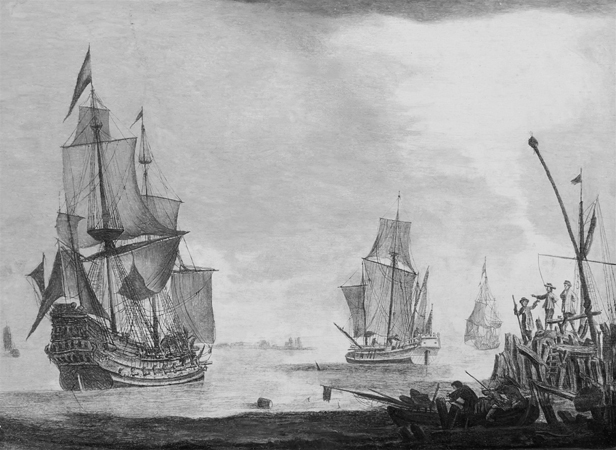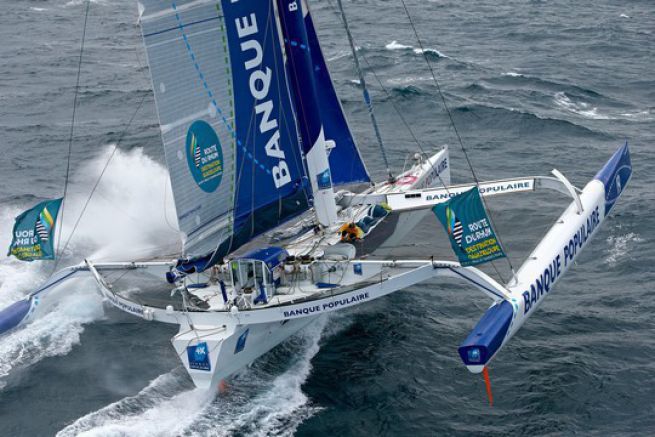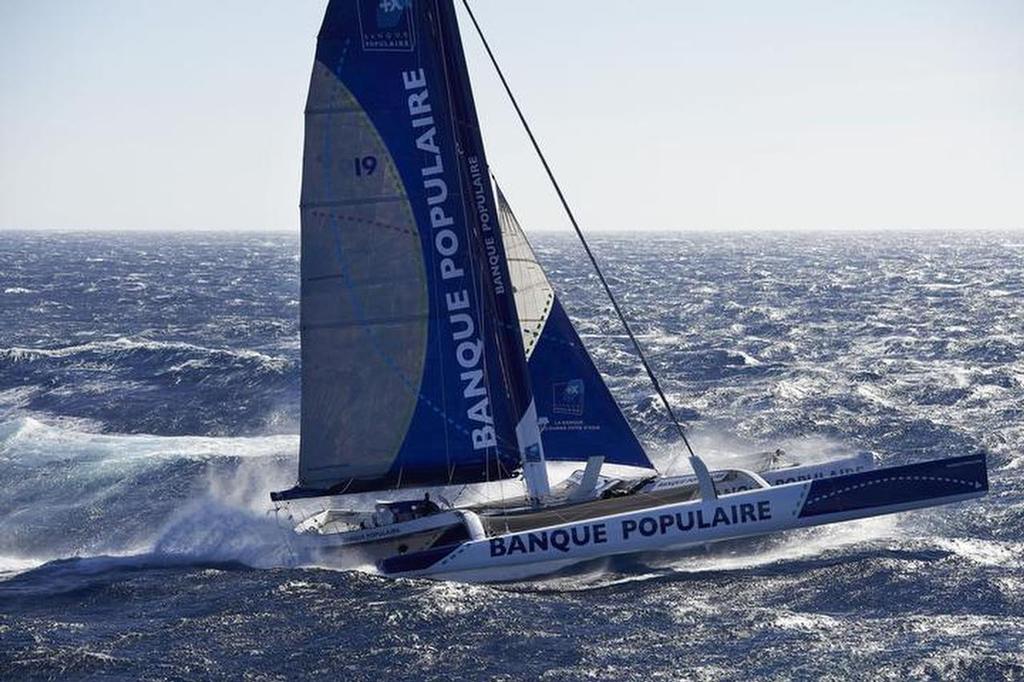EXPLORING THE NORTHERN FRENCH COAST
Over the past several months, we've continued to base ourselves out of Treguier, BRAVO's birthplace, and an area of which we've grown quite fond. It makes a good base to explore the region, and given the realities of visa restrictions (Schengen, British, and French long-stay visas are all in play), Covid restrictions, especially with our American (aka North Korean!!!) passports, and remaining boat bits to be finished by Boreal, we've settled into life in Treguier.
Work on BRAVO is nearly complete, with just a few items remaining on the warranty list. We'll be hauling out next week for Volvo to remove and rebuild the gearbox, which has been giving us problems going into forward gear. Hopefully that will just take one week. A few last bits of sail work and miscellaneous other repairs and we should be good to go, as we prepare to head to the UK in late November. (We'll have to quarantine for 14 days on arrival in Dartmouth, which will be our home for the winter at the town quay. The nice harbormaster there has offered to bring us groceries to the quarantine mooring if we need it!!!).
Note that this post is a bit long, but it includes lots of photos, so hopefully it goes quickly. If not, well, what else are we doing in these Covid days???
We've managed a few coastal cruises this summer, of one to two weeks. All told, we've sailed a bit over 1100 nautical miles.
Here are a few spots we've tucked into...
PAIMPOL:
Paimpol is a sweet Breton village, just around the corner from Treguier as the crow flies, but better than 1/2 day away depending on the tides. It is also at the end of a channel which dries at low tides, and access is via a lock, only reachable within 2 hours each side of high water.
It was exiting the lock that we learned an ESSENTIAL lesson of maneuvering a centerboard boat.....with the board fully retracted in the UP position, they don't respond to the wheel worth a damn!!! So, with our board up due to anxiety about depth in the lock (unfounded fear, as it turned out), when the inner gate opened to the little fishing village, we motored through with the concrete wall on our port (left) side, scraping our brand new rear corner for what seemed an eternity until we could get enough steerage to move away from the wall. I'm sure it provided plenty of excitement to the locals and tourists who see locking boats as a major spectator event. Ughhhhh.....Happily little damage was done except to our egos and a torn BBQ cover which Cindi had sewn the week before. Lesson learned! (Oh, the joys of a metal boat!!! If this had been the teak rail and fiberglass topsides of old BRAVO, it could have been ugly!!!)
Paimpol is a pretty, traditional Breton fishing village, dating back to medieval times, which served as a major port for the Iceland and Newfoundland cod fishing fleet. Looking out at the harbor, it was easy to imagine the port packed with fishing schooners, preparing for their long voyages, or returning home after months at sea.
The port is still a hub for local fishermen, and we enjoyed several days hiking and riding bikes to explore the area.
The large tidal flats make it a major mussel and oyster farming area, and we enjoyed the sidewalk cafes around the harbor.
Boats drying out at the entrance to Paimpol
Bravo at the pier in Paimpol
ST. MALO:
St. Malo was another interesting stop on the Brittany coast with a fascinating history. The walled city, founded by the Gauls in the 1st century BC, has been the fortified home to hundreds of years of privateers, corsairs, and pirates.
 The walls protected the city from raiders from the sea, while the inner harbor gave safe quarter to the ships of the privateers living within.
The walls protected the city from raiders from the sea, while the inner harbor gave safe quarter to the ships of the privateers living within.These walls still stand today. During WW II, Nazi soldiers occupied St. Malo. As the allied forces pushed to liberate France, they repeatedly attacked and bombed the city, destroying many of the old buildings thought to house enemy forces. After the war, the city was rebuilt, with the reconstruction successfully capturing much of the sense of history of the city.

St. Malo, painted c. 1900 by Emil Krause
Entering the inner basin after passing through the lock. (photo from close to the same location as painting above)
Bravo is in the middle of this pic.

French sailors are some of the best racers on the planet, especially when it comes to single handed ocean racing. St. Malo is the start of the Route du Rhum, a single handed trans Atlantic race from France to Guadeloupe in the Caribbean.
The race attracts some of the worlds best, and the winners are permanently commemorated in bronze plaques, set as pavers into the sidewalk around the marina. Here, for example, are the handprints of famous Loik Peyron, who won the 2014 event in 7 days, 15 hours on maxi trimaran Banque Popular VII.

YEE-HAH!!! Must be a handful in a big blow on an inky night passage, especially single handed!!! Here is BP setting a 24-hour solo record of 677 miles, in 2014! With Armel Le Cleac'h aboard, she averaged over 28 knots!!! (Current solo record, by Francois Gabart, also on a trimaran, MACIF, is 850 nm, set in 2018, average speed of over 35 knots!!!)
The St. Malo marina itself is fun to stroll, looking for past and present ocean race boats lying to pontoons and in boatyards all around the area. These are boats that you just don't see in every marina! Here is some of the local boat porn:
Perfect single handed cockpit
Cindi chatting with the lock tenders as we exit the lock of St. Malo.
Iles de Chaussy:
This little archipelago sits nestled in the corner of the Bay of St. Malo. Though it feels very remote, it's proximity to Jersey (in the Channel Islands), Granville and St. Malo makes it a popular boating destination.
Chaussy Sound is in the background, about 1 mile from our "remote" anchorage.
Chaussy Sound, shown in the previous photo, is to the upper left in this shot.
Together with mates Will and Jo aboard their new Boreal 47 SV FYNBOS, we headed to Honfleur in Normandy. It was an excellent cruise, taking us past several of the landing sites of D-Day fame. It was indeed sobering to think about the events of just over 75 years ago, and the many who lost their lives fighting on the beaches here.
Port of Le Havre, across the Seine river from Honfleur
Entering the Seine at sunset, under a squall
Although we were here after peak tourist season, the village is still a major stop on the French tourist circuit. It was easy to see why!
FYNBOS and BRAVO outside the Honfleur basin.
St. Vaast:
We enjoyed exploring this little Normandy fishing port, and got out the bikes for a 40 km ride north to Barfleur.
This is the entrance channel at low tide!!!
Dining at Chez FYNBOS
Isle de Hebihens:
Spectacular view property on this private island.
Classic gaff rigged one design racing!
The Brittany coast is famous for it's rocks, as this unfortunate boat found out this morning. We know, we touched one with our centerboard as well. Happily for us the results were nowhere near as severe.
Happily watching the miles go by...
The Code Zero working fine in a light breeze!
Cindi on night watch in the dog house....dry and warm!!!
Back at our home base in Treguier
OK, we've been sailing for over 50 years. Yup, we're OLD!!! And in all that time, being aground has always been high on the list of things to avoid!!! Yes, it sometimes happens. The old saying, "There are only two types of sailors...'Those who have been aground.....and liars'" really has truth to it. (Yes, we have been aground!)
Having found our spot, the next day we positioned ourselves using both our main anchor, and our stern anchor set from the dinghy. The water at that point was about 6 meters deep, and we just draw a little over 1 meter with the board up. Since the tidal range for the day would be around 8 meters, we'd certainly be high and dry at low tide. We secured the anchors, and sat around to wait.
 All was fine. BRAVO was perfectly level on the sand, allowing easy access to change the prop anode.
All was fine. BRAVO was perfectly level on the sand, allowing easy access to change the prop anode.
 |
| Neighbor with his outriggers deployed. |
But here in Brittany, with the typical 30 foot tidal range, "taking the ground" becomes a way of life. Indeed, boats are designed for it, and many make it an art form, living on their moorings on the beach, drying out twice every 24 hours.
Cruising, Breton style, can mean searching for the next beach to dry out on, giving the sailor a beach condo in every little bay or harbor!
We decided that we needed to change the zinc anode on our propeller. It had been 5 months since BRAVO was launched into the brackish water of the Treguier marina on the tidal Jaudy river. Brackish water is hard on zincs. So it was time for boat maintenance, Breton style. With our centerboard boat, we would give this drying out business a try. Big "gulp".
We decided that we needed to change the zinc anode on our propeller. It had been 5 months since BRAVO was launched into the brackish water of the Treguier marina on the tidal Jaudy river. Brackish water is hard on zincs. So it was time for boat maintenance, Breton style. With our centerboard boat, we would give this drying out business a try. Big "gulp".
We found a likely beach in a deep bay on the west side of a small island Ile de Brehat, and taking a mooring buoy we dinghied in to shore on a scouting mission. The idea is to find a nice flat sandy spot, in between other moored boats, where you can happily spend your hours going down on the tidal elevator, and then, hopefully, back up again!
| Cindi on reconnaissance mission. Note the red "channel buoy"!!! This will be our entry point ! |
Looking behind us, deeper into the bay, we watched as boats slowly began to show bottom paint. The tide line kept getting closer....a very WIERD feeling! We kept adjusting the tension on the stern anchor, winching it in as the boat went steadily lower.
Finally there was no denying it.....we were solidly on the beach. We waited until we were high and dry, and scrambled down the ladder for a walk about.
 All was fine. BRAVO was perfectly level on the sand, allowing easy access to change the prop anode.
All was fine. BRAVO was perfectly level on the sand, allowing easy access to change the prop anode.And then, after a couple of hours, we were floating again, and continued the journey!!! Cruising, Brittany style!!!
Here's to hoping we get a vaccine for Covid soon, and that the US gets a badly needed new president!!!
STAY HEALTHY, EVERYONE!




























































